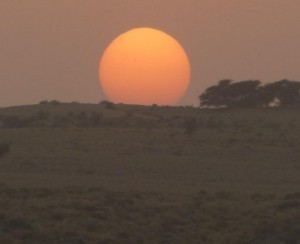Lisa Niver's Blog: We Said Go Travel, page 458
October 28, 2013
Five must-visit Caribbean resorts
With its glorious weather, sandy beaches and lukewarm turquoise seas, the Caribbean islands are seen as a dream holiday destination for many people. Temperatures tend to range from a minimum of 20C in January to above 30C in July, so you can be sure of getting some sunshine whenever you travel.
The one problem that some tourists may have is deciding which island and Caribbean resorts they want to visit. Here Columbus Direct shares a list of five areas which should certainly be considered by any tourist who fancies veering off towards the Caribbean Sea…
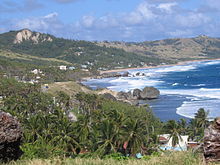
Bathsheba, Barbados
Barbados
Barbados may be one of the smaller Caribbean islands, but it’s home to fun, adventure and paradise that belies its diminutive size. There are more than 70 miles worth of pristine white beaches on which to soak up the sun, enjoy a rum punch or try out some water sports.
The West coast really comes to life at night-time. Its delightful range of bars and restaurants create a carnival atmosphere wherein tourists can eat, drink and dance to jazz, reggae or traditional chart music.
Some of the biggest party nights occur during the island’s annual festivals. The three-day Barbados Food & Wine and Rum Festival begins on November 22nd, whilst the grand celebration of the nation’s independence takes place on November 30. What a perfect excuse to book an end-of-year holiday!
St Lucia
St Lucia could be the perfect choice for those who love the idea of exploring a tropical paradise. The island is covered with miles worth of glorious rainforest to trek through, with plenty of luxury hotels and tourists attractions camped within it.
Visitors are urged to go snorkelling at the foot of the iconic Piton mountains or join a guided tour on a hike up to the top for some of the most incredible views of their surroundings. There’s also the opportunity to try horse-back riding across the beach, take the whole family to a water park or explore the forest wildlife during a relaxing walk on the beach.
Ideally, tourists would visit the island during Carnival celebrations, which run throughout June and July.
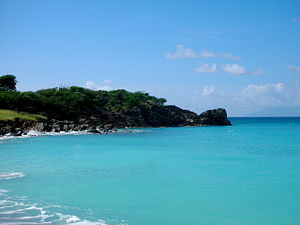
Turner Beach, Antigua
Antigua & Barbuda
Antigua is another hugely popular tourist destination in the Caribbean. Once again, glorious coastlines, fine dining and friendly locals are the norm. Visitors have the opportunity to snorkel with stingrays, zip-line through tropical rainforests or relax on a luxury cruise.
Antigua has its own Carnival which takes place in July, yet others could be more excited by the prospect of National Sailing Week, which falls in April.
There are plenty of boat trips to nearby Barbuda as well. With a population of just 2,000 people, it’s often described as the Caribbean’s best kept secret. It can feel like your own personal tropical island getaway.
Dominican Republic
One of the largest and most vibrant areas of the Caribbean, the Dominican Republic is perfect for those who want their holiday to feature a bit of everything.
There’s 250 miles of coastline to enjoy, but so much see and do in the centre of the island as well. Try white-water rafting through Jarabacoa, exploring underground caves in Juan Dolio or riding a cable car almost 800 metres above sea level in Puerto Plata.
Experience the sights on top of the Caribbean’s largest mountain – the 3,000m+ high Pico Duarteis. Marvel at the beauty of the Caribbean’s largest lake – The Enriquillo. You can even cross the border and enjoy the attractions that neighbouring Haiti has to offer. It really is the island that has it all.
Jamaica
Visit Jamaica and find out that the stereotypical relaxed fun-loving stereotype of the locals is completely true to life. The culture is one of easy living, dance, fun and celebration.
The traditional tourist attractions to enjoy include beaches, bars restaurants and the world-famous Bob Marley museum. But the best way to get the most out of the island is to mix with the friendly locals in the capital Kingston, the party city of Montego Bay or the beautiful coastal region of Ocho Rios.
In truth, the majority of Caribbean islands make for the perfect holiday destination. Those who make the effort to visit any of these fantastic nations can consider themselves truly blessed.
About the Author: Sam Jones is a full time writer who loves to travel to exotic places and experience some of the most unusual and brilliant places the world has to offer. Find him on Google+
The post Five must-visit Caribbean resorts appeared first on We Said Go Travel.
What The Kumbha Mela Taught Me
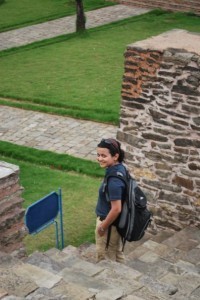 Curiosity, with certain scepticism, made me say yes, when asked if I would like to come along to the Kumbha Mela, the largest religious congregation of people in the world. Curious because over the years, I have seen innumerable photographs that have captured the Mela and wanted to see for myself its appeal.
Curiosity, with certain scepticism, made me say yes, when asked if I would like to come along to the Kumbha Mela, the largest religious congregation of people in the world. Curious because over the years, I have seen innumerable photographs that have captured the Mela and wanted to see for myself its appeal.
To see if the mysticism that gets captured in the photographs is what defines the Mela or is there a bigger story that one has to experience. Sceptical, because I am a person who does not enjoy crowds. I am also a person who believes in praying in private and who finds the throngs at religious places distracting and dare I admit, annoying.
I expected the Mela to leave me with the memory of a kaleidoscope of dramatic and theatrical images. Instead I learnt a subtle lesson from the very crowds of people that I wished to avoid.
It all started as we approached Allahabad, the site of the Mela. As you near the city, you start to notice groups of people, carrying their luggage on their head, making their way purposefully towards their destination, by foot. You don’t know them but understand enough to know that these are people of very modest means, who have made a long and tiring journey with their meagre savings. This is when you first confront the faith that is the bedrock of this Mela.
It is past nine at night when we reach Allahabad and someone suggests a quick look around the Mela grounds. The crowds would have retired for the night and we would get a glimpse of this town that has sprung up for a few weeks, only to be completely dismantled when the Mela ends.
The first thing that will catch your attention when you arrive at the grounds is the sheer size of it. I had read the statistics being bandied about by the media on its size and the logistics involved but when seen with your own eyes; it has the power to stun you into silence. Your eyes will take in the millions of lights and tents that extend as far as your eye can see, the various barricades erected for crowd control, the extensive water and sanitation facilities, the large tents put up by various ashrams and sadhus for their followers, not to miss the gaudy and colourful lights that light up the entrances to these tents. As your eyes take it all in, your ears will pick up strains of an eclectical mix of music emanating from the larger tents that mix with the constant messages, mostly of missing persons, being broadcast by the public announcement system.
But, amidst all that, one sight endures. Around the Mela grounds, you will notice large groups of people, sleeping out in the bitter cold. They sleep huddled together, with their meagre belongings, so desperately poor that they have no choice but to sleep in the open, defenceless and vulnerable. You know that many of them are the same people you saw while entering the city. So compelling is that image that one can’t help think that it must be faith that compels one to endure such hardship to make this journey.
Faith that this journey they make will remove all that is holding them back in life. Faith that compels them to make this journey so that their children can lead better lives. Faith that submits and surrenders to a Higher Power. This is not faith that should be mocked or patronised but rather so pure and simple in its innocence that it is humbling. This is not faith that imposes or interferes but so all-encompassing that it should never be exploited for narrower, parochial aims. This is not faith that tolerates but accepts and accommodates another. This is the faith that defines and explains India. The naysayers will call it blind faith. I call it absolute faith. Such is the power of that image that it mocks your scepticism and melts away your doubts.
So, early next morning, at the time called “Brahma muhurat”, an hour before sunrise, we head towards the Sangam, the point where the rivers Ganga and the Yamuna meet the mythical Saraswati. The place where one takes a dip to wash away the sins of one’s life, present and past.
It is calm and peaceful with an air of expectancy, as we travel by boat. The millions of lights of the Mela grounds shimmering in the water and the river as dark as the pre-dawn sky. Someone jokes lightly, it’s a good thing it is dark, we can’t see how dirty the river is. My thoughts to turn to what my mother had explained before our journey had started, “You may believe that your sins are washed away with the dip, but remember, the person who committed the sins, remains. So, let this dip be symbolic of letting go of all negativity and resolve to be a better person.” A simple sentiment that can never find enough mention.
As we approached the Sangam, there is a line of boats moored, from where one can jump into the waist-deep river. We are among the first to arrive. There is no hesitation, no doubt, no scepticism. I jump into the water, say a prayer for my father and take a dip and surrender. In the largest religious gathering in the world, I would have my moment of private prayer.
On the journey back to the river shore, I would understand why the Kumbha affects so many so deeply. It makes you look inwards and acknowledge your failings. But more importantly, it gives you the hope and resolve, to let go of all negativity and be a better person. In a world where we can be increasingly petty and egoistic, the Kumbha allows us to step back and reassess our lives.
Within an hour, we would leave Allahabad. The crowds of the faithful had only increased. Two days later, I would hear news of a stampede and days later, of heavy rains that would create havoc on the Mela grounds. The images would come back. Of those groups of people and their faith, who had braved all odds to be there. I would say a prayer for them. Because, while I may have gone to assuage my curiosity, they had instead taught me a humbling lesson in faith.
About the Author : Sarvani has learnt that the most unexpected journeys are the most memorable. In the past few years, along with travel, she has developed a passion for baking and writes a blog, ‘Baker-in-Disguise‘
The post What The Kumbha Mela Taught Me appeared first on We Said Go Travel.
October 27, 2013
Florida: Winter’s Tale
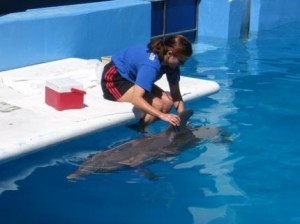 Winter, for some visitors to Clearwater Beach, Florida is a season to escape but for others, especially those in need of inspiration, she’s an animal to seek out.
Winter, for some visitors to Clearwater Beach, Florida is a season to escape but for others, especially those in need of inspiration, she’s an animal to seek out.
Named for the season in which she was rescued, Winter is an eight-year-old dolphin who inspires child amputees, Iraqi war vets and medical researchers interested in recent developments in prosthetic limbs.
At two months old, Winter got caught in a crab trap. By the time rescuers from the Clearwater Marine Aquarium found her, she was not expected to last the night, so severe were her cuts from the trap ropes. Fifty percent of the staff voted to euthanize her, but Winter persevered, minus her tail.
The plucky dolphin started swimming like a fish until experts realized these movements would cause spinal damage. Next came the series of prosthetic tails to match her growth spurts and Winter learning to swim all over again.
As a result of her unfortunate accident and amazing recovery, Winter has become a movie star and a media sensation appearing on “Good Morning America”.
Everyday, visitors to the Clearwater Marine Aquarium can watch Winter interacting with her trainer, Allie Stone, as she adjusts to her new tails. The latest one features a stainless steel joint that propels her forward.
To the delight of Winter and her fans, Allie turns the exercise into a play session. Winter swims around the pool for a few minutes before returning to Allie for pettings and a few adjustments. She appears happy with the new appendage, ducking away when Allie tries to remove it.
Totally impressed with the show, visitors including children, have been donating toys to the dolphins and money to build Winter’s new home. The larger, circular pool allows Winter to swim continuously and provide a hospital emergency room for other rescued sea mammals like her dolphin friend, Nicholas.
Nicholas, a 375 – pound victim of severe sunburn caused by beaching, has been at the aquarium since he was orphaned at six months. Today, he shimmies around the pool in a series of comical forward thrusts while maintaining an upright position.
Spectators reach out to pet him before he darts away to grab a fish from Allie. The dark streaks running from his forehead to his dorsal fin are the only evidence of his life threatening sun exposure.
The show’s grand finale finds Nicholas competing with Rudy, a younger male dolphin, to see who can jump the highest and create the biggest splash, soaking the bolder kids who hug the edge of the pool. Who needs theme parks when young and old alike can enjoy the antics of these mammals at a fraction of the price while supporting a good cause?
Clearwater’s love and respect for her dolphins is also evident in the attitude of her tour boat operators. As a static burst of the ship’s radio advises of dolphin spottings at our six o’clock position, northern tourists rush to the back of the boat, anxiously scanning the powder blue and aqua horizon.
“Dolphins are highly intelligent creatures and sometimes they’re just not in the mood to play. If that’s the case, we’re moving on”, Captain Jack announces.
Fortunately, the duo, lured by the wake of the 40 – foot tug seem eager to follow, albeit from a safe distance. Moving along, Captain Jack reminds us of the strict rules protecting Florida dolphins.
Respecting the dolphins makes good business sense. If these Atlantic bottlenose feel threatened or pursued, they will abandon the area, or worse, beach their young. Most times, according to Captain Jack, the dolphins are happy to play in the wake of the boats and seem almost as curious about the visitors as they are about them. Indeed, scientists have made underwater recordings of dolphins mimicking the delighted squeals of tourists.
While visitors will never see Winter or Nicholas performing on the larger stage of Clearwater Bay, successfully rehabilitated dolphins like Rudy, who have retained their hunting skills, will be playing here for years to come thanks to the staff of the Clearwater Marine Aquarium and the generous donations of loyal fans.
About the Author: Sherell Purcell
The post Florida: Winter’s Tale appeared first on We Said Go Travel.
Arigatō to Japan
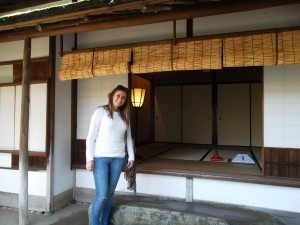 Asante! xièxiè! Gracias! Tack så mycket! The first word any traveller learns in their new destination, Thank you! A phrase which shows humility, compassion, and a sincere gratitude used to acknowledge the new cultures, the diverse lifestyles, and the natural beauty of the place which you are exploring. The past few years have taken me to all corners of the globe, thanking people, children, even animals for the experiences they have given me and the warm hospitality they have shown (most of the time!) One place is etched in my mind however for showing me gratitude, showing me a way to give thanks like no other. This place, this experience was in Tokyo, Japan.
Asante! xièxiè! Gracias! Tack så mycket! The first word any traveller learns in their new destination, Thank you! A phrase which shows humility, compassion, and a sincere gratitude used to acknowledge the new cultures, the diverse lifestyles, and the natural beauty of the place which you are exploring. The past few years have taken me to all corners of the globe, thanking people, children, even animals for the experiences they have given me and the warm hospitality they have shown (most of the time!) One place is etched in my mind however for showing me gratitude, showing me a way to give thanks like no other. This place, this experience was in Tokyo, Japan.
March 2013, I ventured solo to Tokyo for a week. I knew this bustling city, bursting at the seams with people would distract me from any feelings of loneliness. I did not expect to find the peace, serenity and awe inspiring silences which I did. Japan, a country of discipline and innovation, could teach us all something.
I signed up for a Traditional Japanese Tea Drinking Ceremony, ironic for the British traveller who does not drink tea, however I knew this would be far more than just a cup of ‘cha’. We were taken to a small wooden house, nestled in the most pristine of gardens, friendly and welcoming in the cool, crisp March air. We circled the centre table, and sat in expectant silence. A petite, shy, yet self-assured lady emerged from the back door, closing it softly behind her without a sound. Her movements were so precise, so intentional, and so silent that they could not be ignored. She sat composed at the small table on the floor in front us, unfazed by her eager audience. The aroma of the tea was mixed with sheer intrigue and anticipation. Each of us was offered a small lilac sweet, to accompany our tea. There was no rush, no hustle, and each sweet was offered and received with a polite, gentle nod of the head. Once the tea had been prepared, the tea drinking customs were demonstrated to us. There were no words in the Tea Drinking Ceremony, no sound at all in fact, just a series of movements, gestures and customs used to show gratitude. Japan was a country where I thought language would be a problem, but sat in this Tea Ceremony, almost 6,000 miles from home I knew exactly what was being said.
I went over the etiquette of tea drinking over and over in my head, desperate to repay gratitude and discipline I had been shown. I felt clumsy and nervous as my jade coloured cup or ‘Chawan’ was handed to me, without a sound in such a confident, yet friendly manner. I was inspired, I was in awe, and I did not want to disappoint. After an intense, yet tranquil few minutes it was time to drink or tea. We all followed intently, turning our cups clockwise twice, taking three smooth sips of our tea, being sure to leave some for the next guest as tradition suggests, placing our cups back down, and wiping the rim. I sat back, and breathed a sigh of relief, amazed at how this silent and composed atmosphere could make all your senses so alert.
The Tea Ceremony came to an end; it was time to thank our host, and our host to thank us. There are two ways to show gratitude in Japan. It can be said verbally, ‘Arigatō!’ But what does this mean, what does this mean to a traveller who doesn’t speak Japanese? As with every country I go to, I had learnt the phrase for ‘thank you’, but in this unique and awe inspiring culture, in made me question language. Anybody can say thank you, but as we are told, actions speak louder than words. We put our hands together, and bought them up to our chest. I lowered my head, I slowly blinked and bought my head back up, making eye contact with the host on the way up. With a slight smile thanks was given, no words, no language needed. Thank you for sharing your Tea Ceremony with me.
About the Author: Kate Chapman, a secondary school Geography teacher originally from the UK. Currently teaching and living in Singapore, I am travelling and eating my way through as much of (South East) Asia as possible.
The post Arigatō to Japan appeared first on We Said Go Travel.
Iceland: Alone in the Lava
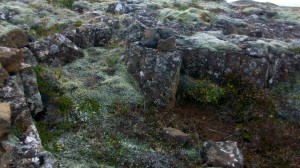 I recently took a trip to Iceland – my first to that country. It was also my first solo traveling venture, as all my previous trips had me visiting friends. I was alone in a foreign country; and with that came all the liberation and all the fear of being totally on my own.
I recently took a trip to Iceland – my first to that country. It was also my first solo traveling venture, as all my previous trips had me visiting friends. I was alone in a foreign country; and with that came all the liberation and all the fear of being totally on my own.
The entire trip had me filled with gratitude. Everyone who had supported me, financially or through simple encouragement; my travel-veteran friends who gave me tips about what to do and not do in Iceland. The family with the cozy apartment who had a room to let. The shop owners who answered my questions, the cafe workers who patiently waited while I counted out my money. These are the people who made Iceland for me.
Being a solo traveler, I was accustomed to being alone in the city, alone among people as I visited shops and museums. Alone in the crowd I was able to absorb the feel of the city. Reykjavik was friendly to loners. But then one day I journeyed out of the city and into the lava.
The map told me that I was in the middle of the lava fields of the Reykjanes peninsula. But really I was in the middle of an ancient ocean, under more sky than I had ever seen. The mountains in the distance, so far away, looked like another country.
Out here, my aloneness was nothing akin to loneliness. This barren plain of black rock was alive with every color. Moss and wild grass and scrubby little bushes all covered in berries. The thrill of seeing a wilderness like this enveloped me like the unceasing wind.
Gravel paths showed me that I was not the only one who came out here to take joy in this wild aloneness. Lava rocks ground to a powder crunched as I walked, louder than the wind. I wanted to walk forever, to follow the dark line made by bicycle tires in the gravel, and see where it took me.
I was filled with awe to be so alone. Filled with awe to be surrounded by so much life. Everyone who had walked these trails before me, from the first Viking boots to the bicycle tires of the man yesterday – they were all my companions.
Iceland, the land of contrasts. The land of fire and ice, to be sure, but also a land of modern cities and unspoiled nature. The restaurants and shops and historic buildings of Reykjavik can entertain, inspire, and not leave you lonely.
I would tell you to go to the lava fields of Iceland if you want to be alone. And in the lava fields you will find that you are not alone after all. With the history beneath your feet and the future in the sky and all around, you’re never alone.
About the Author: Grace Robinson is a writer of fantasy, and a fan of arctic places, world music, mythology, and linguistics. She is a world traveler and author hopeful. Grace currently lives in Virginia with two rabbits and a lot of books.
The post Iceland: Alone in the Lava appeared first on We Said Go Travel.
October 26, 2013
Venice is Sinking
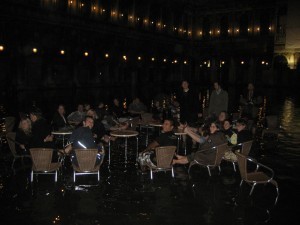 It is midnight in St. Mark’s Square in Venice and the entire piazza is under water. Special tidal conditions and a full moon have caused the water levels to rise a metre and give the impression that one of the world’s most beautiful cities is sinking. A knee-deep flash lagoon covers what Napoleon referred to as ‘the drawing room of Europe’. The still water reflects the small lights of the surrounding buildings and an eerie silence has replaced the normal cacophony of the day. We are the only people here. While the rest of Venice avoids the flood our group of backpackers and hostel buddies has traipsed through deluged streets and alleys with plastic bags on our feet to experience the spectacle.
It is midnight in St. Mark’s Square in Venice and the entire piazza is under water. Special tidal conditions and a full moon have caused the water levels to rise a metre and give the impression that one of the world’s most beautiful cities is sinking. A knee-deep flash lagoon covers what Napoleon referred to as ‘the drawing room of Europe’. The still water reflects the small lights of the surrounding buildings and an eerie silence has replaced the normal cacophony of the day. We are the only people here. While the rest of Venice avoids the flood our group of backpackers and hostel buddies has traipsed through deluged streets and alleys with plastic bags on our feet to experience the spectacle.
At the entrance to the piazza the water is too high and so we stop to take off our shoes and roll up our pants. We know the water is not clean but our excitement overcomes any reservations. As we exultantly wade into the middle of the square we spot chairs and tables from a closed café and take them with us to the centre of this impromptu lake. We form a big circle and pass around bottles of cheap, crude wine and toast to the adventure, to our discovery that seems exclusive.
We are the typical eclectic mix of nationalities, backgrounds and personalities in a European hostel. There are two very likable Aussie guys, a ditzy illustrator from Cornwall, a travel agent from Vancouver, three English teachers from Ireland living in Berlin, two wild Polish girls, a Scottish long-term traveller, a quiet Chilean girl and a handful of Americans who are studying abroad. I work at the hostel and see all types of travellers passing through every day. We are easily drawn together by this spontaneous adventure, this unique shared experience. Young travelers all seem to have the special ability to focus on similarities rather than differences and quickly become friends because of that. It is our most endearing trait.
These open and easy friendships have, however, lost their sheen with me. Into my second year of backpacking I seem to have grown desensitized to the thrill of new friendships, bitterly aware of their inevitable end. Working in a hostel this is magnified and only on rare occasions do guests spend more than three days in Venice. It is indeed a difficult task to continually make friends but to never keep any.
The piazza normally swarms with tourists. They line up to the impressive Doge’s Palace and San Marco’s Basilica, take photographs, eat gelato in the cafes, feed the pigeons or try to make sense of their maps. Souvenir salesmen float amongst them offering their wares while locals dart in between intent on quickly passing through the chaos. Tonight as the moon raised high and the water with it, this day-time hive of activity is transformed into its own perfect contrast. The signature commotion of the day is replaced with a tranquil calm. As our group discusses the wonder of this unique phenomenon we grow merrier and our laughter echoes in the otherwise silent square.
While we lounge in the middle of the shimmering lake, some drift off on their own paths splashing and wading and joking in the water. It feels as if the rest of Venice is sleeping, as if this is our own little secret and our eyes glimmer like the water surrounding us, knowing that it is.
We eventually finish the wine and decide to leave. As we tramp out I look back and revel in this special night. By morning the water will be gone and the crowds will be back, like nothing ever happened. In the next few days all of the backpackers will set off in different directions never to meet again. Should I resent both for their temporary natures?
I realize that the fleetingness of both is inescapable. The uniqueness of the flooding is what made it so special and maybe that is how I should see the passing friendships. These special moments and brief companions are small aspects of what makes travel and exploration what it is. I realize that instead of wishing it were different, I should enjoy it for what it is. I should appreciate that it has happened at all. With that in mind I take one final look, turn and leave.
About the Author: Matt is a drifter under the guise of going home when he finally decides what he wants to do with the rest of his life. He happily ignores the topic and keeps on drifting.
The post Venice is Sinking appeared first on We Said Go Travel.
A Simple Safari In The Jaisalmer Desert – India
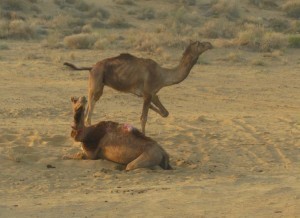 Rajasthan, Northern India. 2 hours away from the Pakistan border. Our location was Jailsalmer. I never imagined I would be in this territory in my life. I had made my way up from the southern parts of Kerala, through Goa, Mumbai, and Udaipur consisting of long train journeys, regularly awoken by the sound of ‘Chai’ from local sellers of the popular Indian tea. Reaching the desert, I felt like I was an explorer reaching unknown lands, coming across the end of the world.. Alexander the Great once travelled through India, to the Western world then in BC time it was a new adventure, to me in 2013, and this was also the case.
Rajasthan, Northern India. 2 hours away from the Pakistan border. Our location was Jailsalmer. I never imagined I would be in this territory in my life. I had made my way up from the southern parts of Kerala, through Goa, Mumbai, and Udaipur consisting of long train journeys, regularly awoken by the sound of ‘Chai’ from local sellers of the popular Indian tea. Reaching the desert, I felt like I was an explorer reaching unknown lands, coming across the end of the world.. Alexander the Great once travelled through India, to the Western world then in BC time it was a new adventure, to me in 2013, and this was also the case.
This was an experience I had longed for since coming to India, I wanted to ride a camel, trek to the harsh desert, to see the mountains and dunes of sand in my path. I wanted this challenge, having the perception that it was survival of the fittest. Four of us took a tour from Jaisalmer with the tour company called the Trotters. They were recommended from a friend of mine from England. The name of the company is copied from the famous British Sitcom TV show ‘Only Fools and Horses’. The two main stars were the South-East London Brothers, Del Boy and Rodney Trotter. It was a good name and certainly to the British like me, it got the attention. Our route began as we drove out via Jeep to the outskirts of the desert.
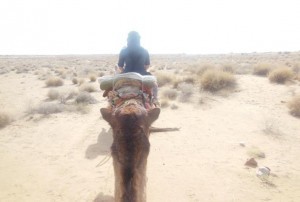 By the time we reached our spot, there were 8 of us in total, with camels ready and waiting. At that point, I had never been that close up to a camel. For me, they are lazy-looking animals, but more towering in size than I had initially expected. They were fairly co-operative, plodding along the sand, only stopping for a quick munch of any green plant they could find. I had packed alot of water with me, a bandana wrapped around most of my head, and a long sleeved loose shirt covering the upper part of my body. The sun was extreme, I had to take precaution, although I had been on the road nearly 7 months by then across Asia, I have had trouble with the sun in previous years. I was frightened of sunstroke but I had learnt from it. This was the survival part of this trip I liked. Although in hot circumstances, it was almost a challenge to overcome this. Hostile heat and basic conditions, this was no five star resorts. It was for the ones who wanted it, who didn’t mind sharing a cup of Chai, or eating Rice from a Pan heated up from manmade fire.
By the time we reached our spot, there were 8 of us in total, with camels ready and waiting. At that point, I had never been that close up to a camel. For me, they are lazy-looking animals, but more towering in size than I had initially expected. They were fairly co-operative, plodding along the sand, only stopping for a quick munch of any green plant they could find. I had packed alot of water with me, a bandana wrapped around most of my head, and a long sleeved loose shirt covering the upper part of my body. The sun was extreme, I had to take precaution, although I had been on the road nearly 7 months by then across Asia, I have had trouble with the sun in previous years. I was frightened of sunstroke but I had learnt from it. This was the survival part of this trip I liked. Although in hot circumstances, it was almost a challenge to overcome this. Hostile heat and basic conditions, this was no five star resorts. It was for the ones who wanted it, who didn’t mind sharing a cup of Chai, or eating Rice from a Pan heated up from manmade fire.
There was nothing else in site apart from layers and layers of sand. There were no towns, no shelter, and no lakes. We were in a land of pure isolation. It was a journey battling the bumps of the sandy path until we got to our spot to stay. The camels were left to frolic around us, it was wonderful to see their freedom as animals as not as a form of living transport. A jeep with a couple further tour guides joined us after we found our spot.
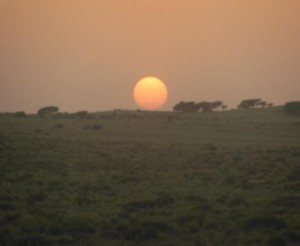 We checked out the Sandunes, climbing them and playing around in their smooth existence. When that moment arrived, it was unexpected to be as jaw dropping as it was. It was something out of a sci-fi movie, a golden ball of fire in full force visible to view its whole circumference to the naked eye, a purely magical moment that any photographer in the world would pay for. It almost looked like a painting of a picture, or a NASA satellites image zoomed close in for us all to see. It was really there, right upon our very eyes for us to fully embrace.
We checked out the Sandunes, climbing them and playing around in their smooth existence. When that moment arrived, it was unexpected to be as jaw dropping as it was. It was something out of a sci-fi movie, a golden ball of fire in full force visible to view its whole circumference to the naked eye, a purely magical moment that any photographer in the world would pay for. It almost looked like a painting of a picture, or a NASA satellites image zoomed close in for us all to see. It was really there, right upon our very eyes for us to fully embrace.
I slept on the roof of the Jeep that night, under the thousands and thousands of stars above us. It was an astronomers dream as the sky was clear, the universe in full vision. I finally slept when the night was dark, comforted by the air being cool.
A 6am wakeup was natural, being outdoors, the sun’s rising rays lighting up the desert. We ate some breakfast, drank some water and battled back before the sun hit its peak of midday. I felt fulfilled; it was my first real safari. There isn’t much more to say about it, it was just appreciating the natural features of the world. Appreciating life that is so far away from our modern day to day life, yet such a simple experience I never thought I’d manage to achieve.
The post A Simple Safari In The Jaisalmer Desert – India appeared first on We Said Go Travel.
Budapest: The Tower on Top of the Hill
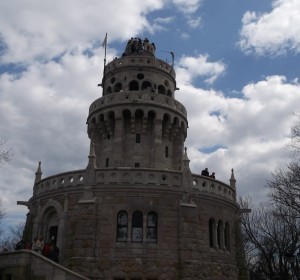 It was a hot day in July 2011. My third trip to Budapest but the first time I would make it off-the-beaten track. My now husband – then boyfriend – suggested we should visit a tower on top of a hill. He’s always known about my passion for climbing to the top of…anything possible to climb and my fascination with towers, especially if they have an interesting history.
It was a hot day in July 2011. My third trip to Budapest but the first time I would make it off-the-beaten track. My now husband – then boyfriend – suggested we should visit a tower on top of a hill. He’s always known about my passion for climbing to the top of…anything possible to climb and my fascination with towers, especially if they have an interesting history.
Elisabeth Lookout (or Elisabeth Tower) is located on top of János Hill, at the highest point of Budapest, Hungary’s capital. The tower is built in neo-Romanesque style and is 23.5 m high. But since it’s already high on the hill, the views are just…majestic.
It is free to visit but you need to tackle the 101 steps which lead to the very top of it. And lovers, bring a love lock, as at the top you’ll find a place to put it, along with other love locks which made their way here.
Built in 1908-1910, the tower attracts visitors especially on lovely spring and autumn days. Summers can be scorching hot while getting there during winter can be a hassle. The easiest way to get to the tower is on the Cogwheel, followed by a short trip on the Children’s Railway and a hike in the woods. Alternatively, there is a chairlift which can take you close to the tower and the walk is shorter.
But I am not writing to give history lessons and directions. I was about to tell you why this tower inspired awe. It was a hot, stuffy day in July. By the middle of the hike it started to drizzle which made us huff and puff, moaning that we are not fit enough. We finally made it to where the chairlift stops and were contemplating another hike, to get to the tower itself, but this time we faced a much steeper incline. My bad knee was screaming with each step but I pushed forward, until I could see the white marble of the tower. I stop. I gazed. I was…in awe. I was mesmerized by its beauty and majestic feel.
We stopped to take some photos with the tower and I was utterly fascinated. I wanted to learn about it, read it about it – the history is presented at the chamber at the base of the tower but it’s in Hungarian. I struggled to understand without asking my boyfriend to translate everything. I was fascinated.
We started going up the stairs and taking photos at each of the levels where there are viewing platforms. I saw the surrounding areas, the vastness of the Hungarian land and I wouldn’t want to leave. First time I didn’t make it to the top (it was very windy and I was afraid to go alone). But I badly wanted to be back.
And I was back in April 2013. This time as husband and wife. And this time, I climbed to the very top and took in the even more impressive view. And relieved every single second of my previous visit. It was very crowded now, though as we happened to get to the tower on a sunny spring day.
Budapest doesn’t cease to amaze me. Whether it was the third visit or the sixth. And hopefully the seventh (next year) will bring some more interesting adventures for us.
About the Author: Traveling Cricket: Travel writer, passionate photographer, in love with London, Budapest and Athens.
The post Budapest: The Tower on Top of the Hill appeared first on We Said Go Travel.
October 25, 2013
Nigeria, My Country: What it means to me
I would like to explain some of the above words in a clear and concise manner.
Gratitude; according to the Seventh Edition of the Oxford Learners Dictionary, it simply connotes with the feeling of being grateful and wanting to express your thanks. Inspire; it means giving somebody the desire, confidence or enthusiasm to do something well. Awe; as it connotes to the topic simply conveys the sense of wonder and amazement, it shows feelings of being impressed by something.
Nigeria as it connotes to the topic is a country on the coast of West Africa, the country was eventually claimed by the British, who consolidated the area into one colony in 1960, Abuja is the official capital. Having taken in consideration the literal meaning of the above words, I will now expand with series of logical proportions what makes the country awe inspiring and what it meant to me.
To begin with, Nigeria is a land of opportunity to explore new challenges and the freedom to make personal decisions along life’s adventurous journey, experiencing highs and even road bumps along the way, being Nigerian to me means having the opportunity to freely express myself and my opinions and to know that my country is a safe and friendly place to live. The country’s cultural heritage is woven from threads of history and diversity, legend and conquest, the country is known for her multi-ethnic etiquette, manners and protocols, the food which embellishes a rich blend of traditionally African carbohydrates such as yam and cassava as well as vegetable soup made from native green leaves are some of the food culture of this diversity country, though a multi-ethnic group but the styles of folk music are so related to the multitudes of ethnic groups which signifies that this diversity country is so peaked in unity in diversity, in traditional arts, Nigeria has distinguished herself over the centuries in the field of arts, their versatility in arts is so great, the country has in centuries being viewed in all the world as the principal trustee of durable fruits of black artistic genius, tourists visiting the country will gain insight to a glorious past as well as a promising future, set amid of the natural beauty of this diversity country. I did a tour of different countries and discovered that the country is highly admired when it comes to art, moreover, the country is nature preservers, without outwardly showing it, Nigerians are patriotic people when it comes to culture, the country’s cultural heritage has classified her as a place of acceptance of diversity and people’s heritage, a cultural country that allows people to live in relative harmony with inclusiveness.
Nevertheless, Nigeria means a home of democracy; ‘‘we attract hearts by the qualities we display, we retain them by the qualities we possess’’. The country is admired when it comes to democracy because she understood that democracy is an imperative for good governance, the nation has configured its politics to policy, the country is politically stable, which means that the diversity country is secure, predictable, reliable and hard to knock over, the majority are happy because they feel at stake and are not excluded from the mainstream of sustainable development. I so much admire the policy of this diversity country because it is accountable and transparent, the leaders profession (e.g. philosophy, literary criticism, sociology, law, political analysis, theoretical science, etc) solely involve production and dissemination of ideas, she is known for political stability, foreigners attention are always peaked in her democratic nature because her leadership implied a distinction when compared to other countries, the Nigeria as I know nurtures people of great calibre, leaders of notable cultural and artistic expertise whose knowledge grant them intellectual authority in public discourse.
Indeed, Nigeria is a country for travellers to explore the good of nature because the natural beauty of this diversity country is so inspiring.
About the Author: My names are Ikegwu Michael Chukwudi, I am a Nigerian and a secondary School graduate. I enjoy getting to know other peoples culture since I am culturally diverse. I also enjoy reading and writing. I am social, kind and easy going.
The post Nigeria, My Country: What it means to me appeared first on We Said Go Travel.
New Hampshire: Revisiting Lake Winnipesaukee – Part 1
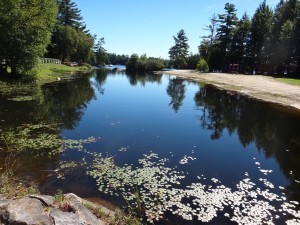
Lake Winnipesaukee (a Golden Pond)
Lake Winnipesaukee the largest of the lakes in the Lakes Region of New Hampshire seemed like a perfect place for a short vacation and a nice follow up to my article on a similar subject – eating around Lake Winnipesaukee.
I really wanted this whirlwind trip to be special as I was introducing someone new to the area. The first thing that had to happen was getting there. With a pit stop or two it takes about 4 hours to drive from Montreal. The one stop I always like to make is in Derby, Vermont just south of the border.
There lies an exceptional Mobile Mini Mart off Rt. 5 that prepares hoagies (foot long sandwiches) daily that my family has been eating for over 20 years. The store manager nods his greetings – he’s been there for 16 years. The sandwiches haven’t changed a bit. My usual choice is sliced Turkey with Provolone cheese, thinly sliced onions, a little mayo and shredded lettuce.
This is my equivalent of lunch autopilot despite other options like Tuna and a mean Roast Beef. The accompaniments are crucial in making the experience. You need to pick out the right bag of salty snack (in this case two bags; “Smartfood” white cheddar popcorn and flavor contest winning Lay’s cheesy garlic bread chips). Next comes your cold beverage from the giant wall of fridges. I usually grab a single Snapple Peach iced tea, but at 2 for $2 I snap up both Raspberry and “Lemon” by mistake. My lovely co-pilot opts for Green Mountain coffee. Finally for dessert, a bag of peanut butter filled M & M’s and a Take 5 candy bar (excellent despite having a dry pretzel center).
For a driving snack we take along Vermont made Maple Beef Jerky for only $2.99. On the road again we cross into New Hampshire, with a highlight of the drive south on Highway 93 – the ride through Franconia Notch State Park. You knew you were getting closer when you saw the rocky outline of the Old Man’s face proudly watching over from the top of the ridge, referring to the former ‘Old Man of the Mountain’ (portrayed on many State signs). The problem is trying to imagine where he once stood and point it out to first timers while trying not to drive off the one lane parkway. It’s hard to believe The Old Man fell down in our lifetime after being there for countless years (I guess that’s what fridge magnets are for). Exit 25 off the 93 comes up relatively quickly and is the scenic way to get into Center Harbor on Lake Winnipesaukee. It takes you via route 175, then onto 3 and 25B. The bonus is you get to ride through the pleasant town of Holderness. There are neat places to stretch your legs including the newly renovated Squam Lakes Inn’s Market Place which apart from selling baked goods, gifts and sundries has cans of silver and blue energy drinks (a.k.a. Red Bull).
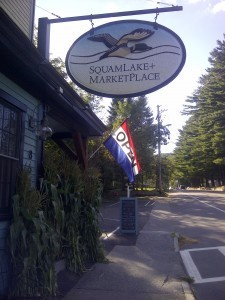
A pit stop on the way to Lake Winnipesaukee
Squam Lake for those that don’t know is where they filmed “On Golden Pond” (the 1981 classic starring Henry Fonda). Film set or not, the area is pristine as lakeside towns go and meandering down the semi-rural roads is always picturesque. A glimpse of the big lake appears through the forest (no need to mention we’re getting close). Route 3 encompasses much of the lake and we get to the T-junction for Moutonbourough Neck road. It’s a gentle curving, tree and camp lined road passing several private condo developments that leads to a little piece of heaven. Deer and other forest dwelling creatures can be prevalent (thus abide by the speed limit for the benefit of both man and beast).
I’ve seen several “I brake for Moose” bumper stickers over the years (see one up close and you’ll know why). Before the bridge to the island at the end of the neck road, you come across a welcome sight (that is if you like to eat and drink). Jo-Jo’s Country Store has been a fixture and place of happy vacationers for as long as anyone can remember. I heard it was recently bought by a large supermarket chain, yet still has it’s local charm.
On this quick stop only Samuel Adams Limited Pumpkin Ale, and a bottle of Barefoot Merlot were purchased. Despite not being a big drinker myself there are some relaxation requisites. Upon arrival to my cousin’s condo we quickly unloaded the trunk, aired out the condo and started our decompression. Since we’d be driving out to dinner, I saved the drinking for BBQ night (see New Hampshire: Revisiting Lake Winnipesaukee Part 2), so I let the sunset serve as my serenity. Later that night we ventured out to Buckey’s Restaurant (240 Governor Wentworth Hwy).
It was 8pm so I wasn’t concerned when the dining room was sparsely filled (folks tend to eat early around the lake). Hearing the blackboard specials I noticed a Montreal Rib Steak on the menu – our server volunteered it was simply a Rib Steak with Montreal Steak Spice on top (how cliché). We decided to share the full rack of ribs, with 2 sides; onion rings and coleslaw for $21. The rib sauce was tangy and Texan in taste, although you needed the serrated blade to cut the meat off the hefty bones. There was plenty in that department, but I was not impressed with the “onion-less” onion rings (the onion centers had dried up). The coleslaw was shredded well and creamy yet not enough to balance the somewhat dry meat we ended up gnawing on. I probably should have splurged for the fried scallops or steak tips, but our server did say ribs were one of the top 3 specialties. After a long day on the road we were content to go back and stargaze the lake sky. Adding to the quintessential lakeside list was a Boston Red Sox game on the tube (versus the Yankees – bonus).
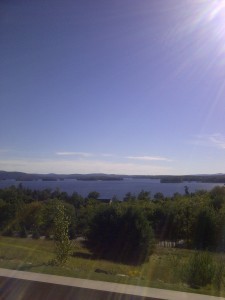
Sun beamed Southern facing view
Watching a few innings, I grabbed some rich New England Vanilla ice cream topped with some blueberries and raspberries ‘et viola’ a nice ending to the first night in the Lakes Region. The baseball game was a nail biter, but was too tired to worry. It was time to turn in for a much needed sleep. Lobster Rolls and the best breakfast spot around would be in my dreams (see New Hampshire: Revisiting Lake Winnipesaukee Part 2). I was out like a light before I could add “On Golden Pond” to my must watch DVD (ie. VHS rental) list.
Look for PART TWO next week!
Jeff Shoer: Having traveled the earth in search of a happy stomach. Jeff continues to follow a path to food loving destinations. He hopes to walk off the calories en-route to more great tastes.
The post New Hampshire: Revisiting Lake Winnipesaukee – Part 1 appeared first on We Said Go Travel.
We Said Go Travel
We Said Go Travel is a global community of over sixteen hundred writers with articles from every continent.
Stories are shared with photos and video from a perspective of the transformative power of travel. We Said Go Travel has hosted live and online events as well as travel writing contests around the world. ...more
- Lisa Niver's profile
- 57 followers


